How to remove apps promoting the pushnote.top page
Notification SpamAlso Known As: Ads by pushnote.top
Get free scan and check if your device is infected.
Remove it nowTo use full-featured product, you have to purchase a license for Combo Cleaner. Seven days free trial available. Combo Cleaner is owned and operated by RCS LT, the parent company of PCRisk.com.
What kind of page is pushnote[.]top?
When visited, pushnote[.]top can either ask for permission to show notifications (load its deceptive content) or open a couple of other untrustworthy websites - it depends on the geolocation of its visitor. In one way or another, pages like pushnote[.]top should be avoided. It is important to mention that users rarely visit websites of this type intentionally.
Most of the times these sites get opened through other pages of this kind, deceptive ads or by installed potentially unwanted applications (PUAs). There are lots of websites like pushnote[.]top, some examples are agazinethede[.]biz, worldactualstories[.]com, and mahaidroagra[.]com.
![pushnote[.]top pop-up redirects](/images/stories/screenshots202106/pushnote-top-ads-main.jpg)
Pushnote[.]top overview
It is known that pushnote[.]top can load a message asking to click the "Allow" button to continue loading the page. This page suggests that it cannot be loaded unless visitors agree to get its notifications.
It is strongly recommended not to allow pushnote[.]top or any similar website to show notifications. As a rule, their notifications are used to promote questionable websites, applications, etc.
It is worth mentioning that other pages of this type can display fake CAPTCHA tests or use other clickbait techniques to trick their visitors into clicking the "Allow" button. Furthermore, instead of loading its content pushnote[.]top may open a couple of other untrustworthy websites.
It is common for pages like this one to be used to promote pages designed to extract some personal information (e.g., login credentials, credit card details), to trick visitors into downloading or installing unwanted software (e.g., adware, browser hijackers), and so on. Some examples of pages that pushnote[.]top may open are "Firewall Spyware Alert", "Norton Antivirus 2021 Update", and "Instagram Copyright Infringement".
If a browser opens pushnote[.]top and other untrustworthy websites regularly, it is likely that it has some PUA installed on it. It is common for PUAs to be designed to promote pages like pushnote[.]top and generate ads as well.
Usually, those ads are used to advertise questionable websites. Sometimes, they can be used to distribute unwanted apps by designing them to run certain scripts. PUAs generate banners, coupons, pop-up ads, surveys, or other advertisements.
Furthermore, apps of this kind can be monetized by using them as a tool to collect data related to web browsing activities (e.g., IP addresses, geolocations, addresses of opened pages, entered search queries), or even sensitive information.
The biggest problem is that information gathered by PUAs may be misused for malicious purposes, for example, to steal identities, personal online accounts, make unauthorized purchases. Therefore, it is highly advisable not to have any PUAs installed on browsers and computers.
| Name | Ads by pushnote.top |
| Threat Type | Push notifications ads, Unwanted ads, Pop-up ads |
| Detection Names | alphaMountain.ai (Suspicious), Emsisoft (Suspicious), Fortinet (Spam), Full List Of Detections (VirusTotal) |
| Serving IP Address | 172.67.223.183 |
| Symptoms | Seeing advertisements not originating from the sites you are browsing. Intrusive pop-up ads. Decreased Internet browsing speed. |
| Distribution Methods | Deceptive pop-up ads, potentially unwanted applications (adware) |
| Damage | Decreased computer performance, browser tracking - privacy issues, possible additional malware infections. |
| Malware Removal (Windows) |
To eliminate possible malware infections, scan your computer with legitimate antivirus software. Our security researchers recommend using Combo Cleaner. Download Combo CleanerTo use full-featured product, you have to purchase a license for Combo Cleaner. 7 days free trial available. Combo Cleaner is owned and operated by RCS LT, the parent company of PCRisk.com. |
To summarize, it is recommended to avoid visiting pushnote[.]top and downloading (and installing) potentially unwanted applications. It is worth mentioning that PUAs can be advertised as legitimate. However, most of them are designed only to generate revenue for their developers and often in questionable ways.
In other words, it is common for PUAs to be useless to their users. The main reason why apps of this kind are called potentially unwanted is that users rarely download or install them knowingly. Instructions on how to remove already installed PUAs are provided below.
How did adware install on my computer?
In most cases, users download or install potentially unwanted applications together with other programs - when they finish downloads or installations without declining unwanted offers. It is common that downloaders, installers with certain settings are used to distribute PUAs.
As a rule, unwanted offers can be found and declined in their "Advanced", "Custom", "Manual" or other settings, or by unticking ticked checkboxes. It is worth mentioning that sometimes users cause unwanted downloads, installations through deceptive advertisements - by clicking ads designed to execute certain scripts. It is worthwhile to mention that those ads appear mainly on questionable sites.
How to avoid installation of potentially unwanted applications?
Third-party downloaders and installers, Peer-to-Peer networks (like torrent clients, eMule, etc.), unofficial websites, free file hosting sites, etc., should not be used to download or install programs. It is recommended to use official websites and direct links for that. Downloads and installations should not be finished without checking downloaders and installers for "Advanced", "Custom", "Manual" settings, or checkboxes.
It is common that those settings/options mention unwanted offers and can be used to decline them. Advertisements displayed on questionable, untrustworthy websites should not be trusted (clicked).
It is common that users open shady pages or even cause unwanted downloads or installations by clicking those ads. Unwanted, unknown extensions, add-ons, plug-ins installed on a browser should be uninstalled.
Suspicious software installed on the operating system should be removed too. If your computer is already infected with rogue applications, we recommend running a scan with Combo Cleaner Antivirus for Windows to automatically eliminate them.
Appearance of pushnote[.]top website (GIF):
![pushnote[.]top website appearance (GIF)](/images/stories/screenshots202106/pushnote-top-ads-appearance.gif)
Notification from pushnote[.]top:
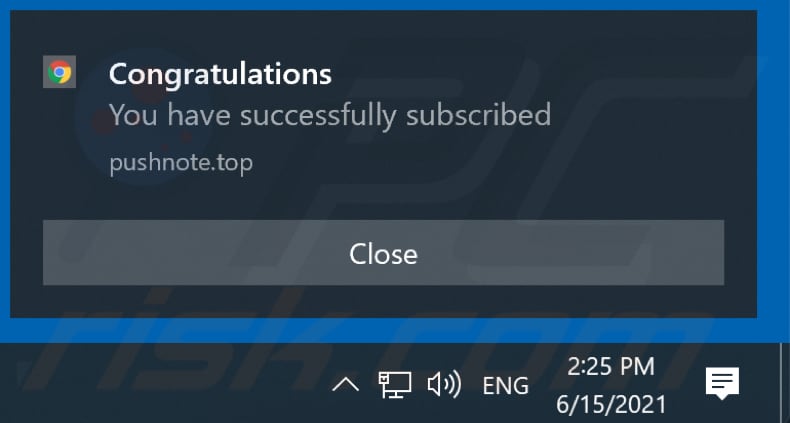
Instant automatic malware removal:
Manual threat removal might be a lengthy and complicated process that requires advanced IT skills. Combo Cleaner is a professional automatic malware removal tool that is recommended to get rid of malware. Download it by clicking the button below:
DOWNLOAD Combo CleanerBy downloading any software listed on this website you agree to our Privacy Policy and Terms of Use. To use full-featured product, you have to purchase a license for Combo Cleaner. 7 days free trial available. Combo Cleaner is owned and operated by RCS LT, the parent company of PCRisk.com.
Quick menu:
- What is Ads by pushnote.top?
- STEP 1. Remove spam notifications from Google Chrome
- STEP 2. Remove spam notifications from Google Chrome (Android)
- STEP 3. Remove spam notifications from Mozilla Firefox
- STEP 4. Remove spam notifications from Microsoft Edge
- STEP 5. Remove spam notifications from Safari (macOS)
Disable unwanted browser notifications:
Video showing how to disable web browser notifications:
 Remove spam notifications from Google Chrome:
Remove spam notifications from Google Chrome:
Click the Menu button (three dots) on the right upper corner of the screen and select "Settings". In the opened window select "Privacy and security", then click on "Site Settings" and choose "Notifications".
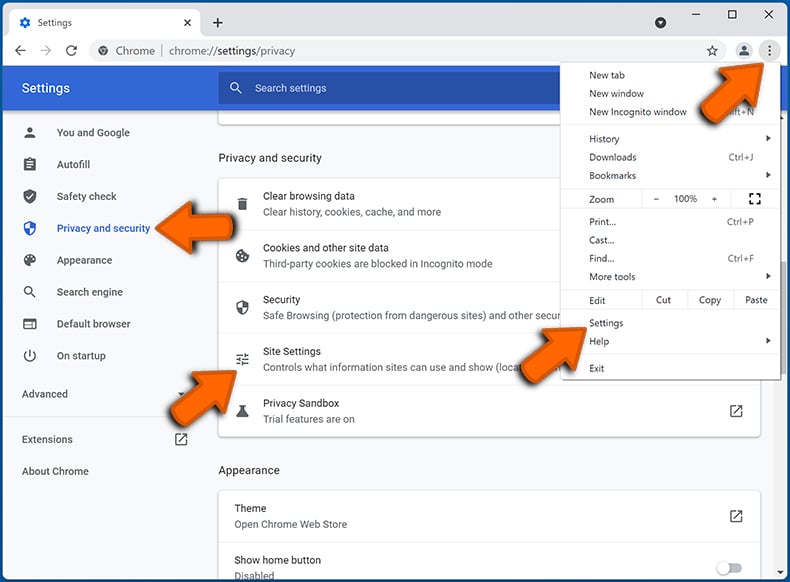
In the "Allowed to send notifications" list search for websites that you want to stop receiving notifications from. Click on the three dots icon near the website URL and click "Block" or "Remove" (if you click "Remove" and visit the malicious site once more, it will ask to enable notifications again).
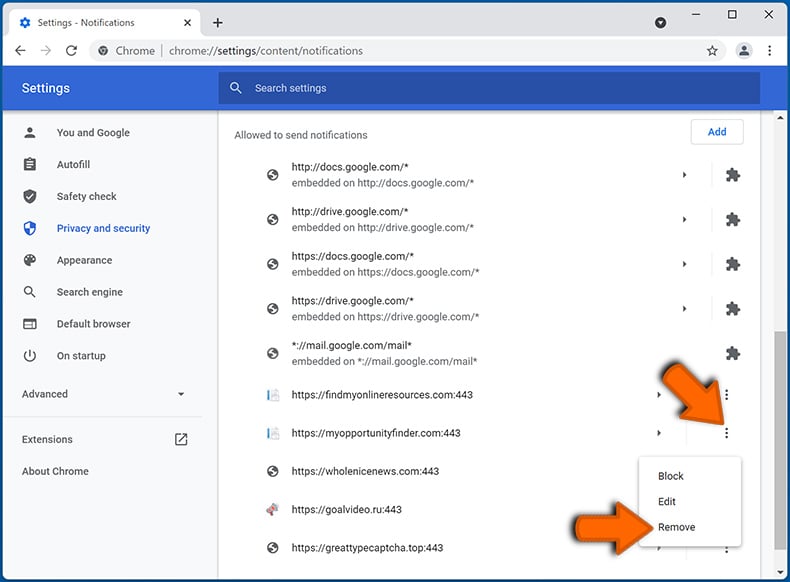
 Remove spam notifications from Google Chrome (Android):
Remove spam notifications from Google Chrome (Android):
Tap the Menu button (three dots) on the right upper corner of the screen and select "Settings". Scroll down, tap on "Site settings" and then "Notifications".
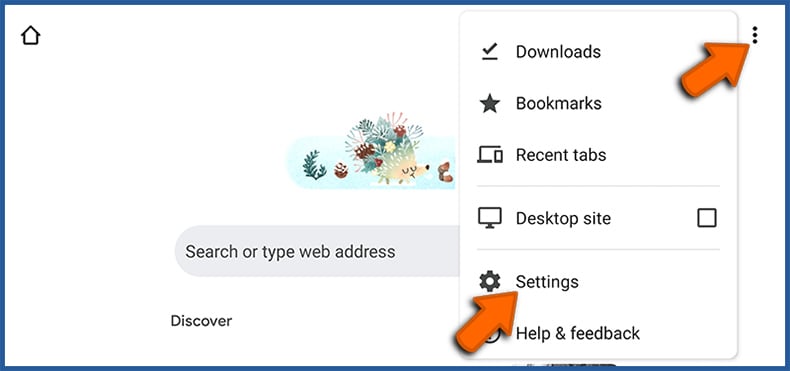
In the opened window, locate all suspicious URLs and tap on them one-by-one. Once the pop-up shows up, select either "Block" or "Remove" (if you tap "Remove" and visit the malicious site once more, it will ask to enable notifications again).
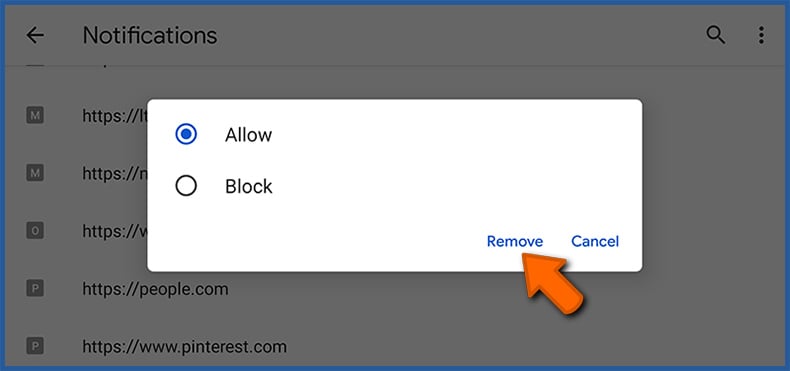
 Remove spam notifications from Mozilla Firefox:
Remove spam notifications from Mozilla Firefox:
Click the Menu button (three bars) on the right upper corner of the screen. Select "Settings" and click on "Privacy & Security" in the toolbar on the left hand side of the screen. Scroll down to the "Permissions" section and click the "Settings" button next to "Notifications".
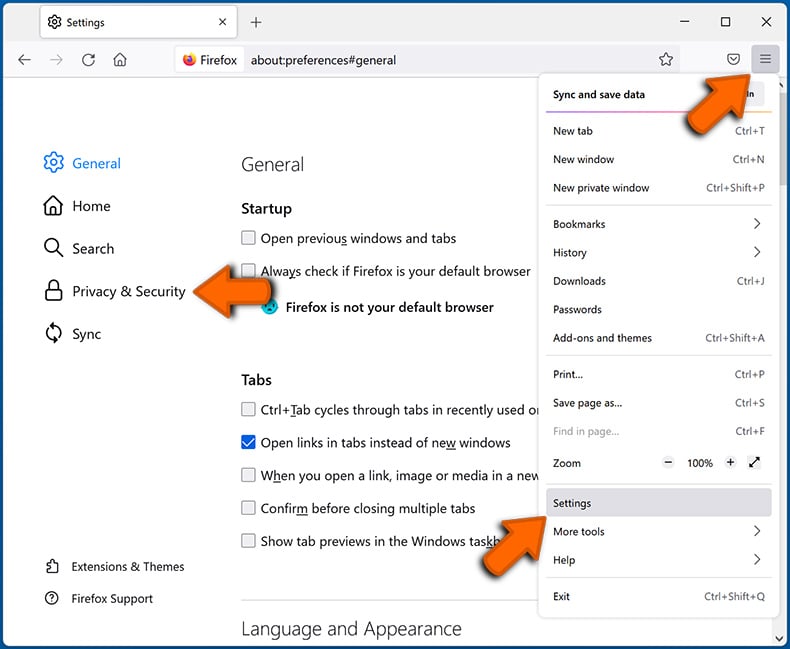
In the opened window, locate all suspicious URLs and block them using the drop-down menu or either remove them by clicking "Remove Website" at the bottom of the window (if you click "Remove Website" and visit the malicious site once more, it will ask to enable notifications again).
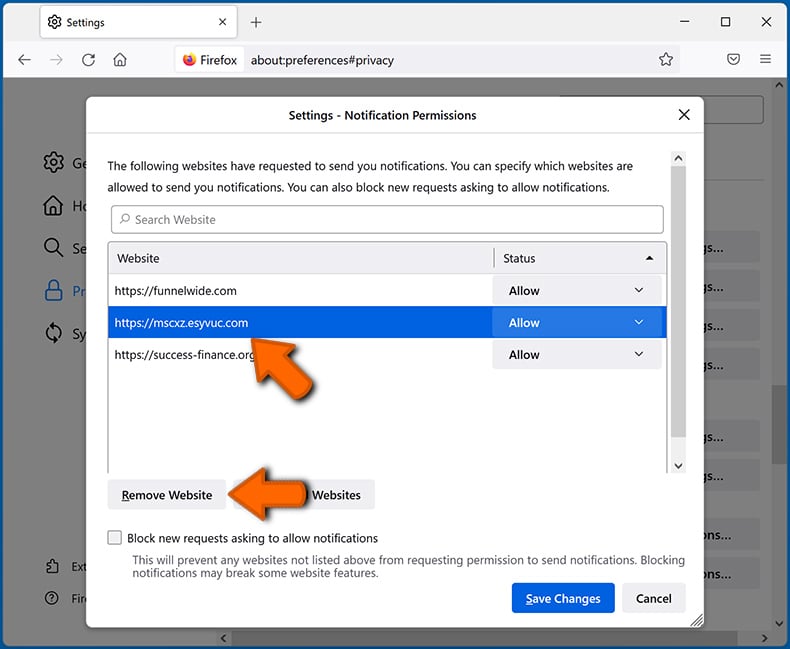
 Remove spam notifications from Microsoft Edge:
Remove spam notifications from Microsoft Edge:
Click the menu button (three dots) on the right upper corner of the Edge window and select "Settings". Click on "Cookies and site permissions" in the toolbar on the left hand side of the screen and select "Notifications".
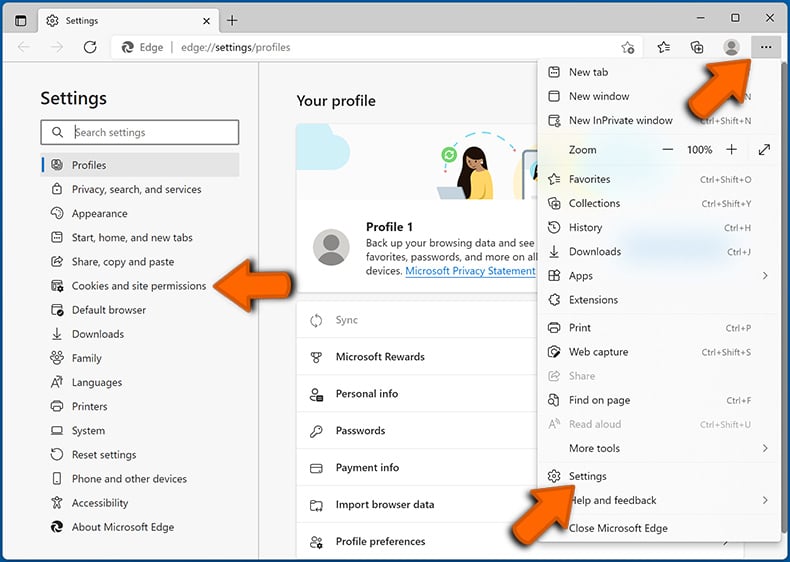
Click three dots on the right hand side of each suspicious URL under "Allow" section and click "Block" or "Remove" (if you click "Remove" and visit the malicious site once more, it will ask to enable notifications again).
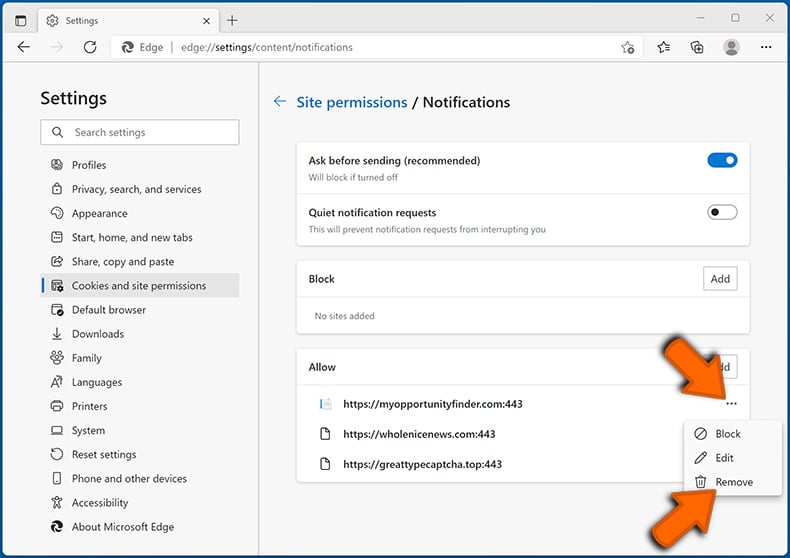
 Remove spam notifications from Safari (macOS):
Remove spam notifications from Safari (macOS):
Click "Safari" button on the left upper corner of the screen and select "Preferences...". Select the "Websites" tab and then select "Notifications" section on the left pane.
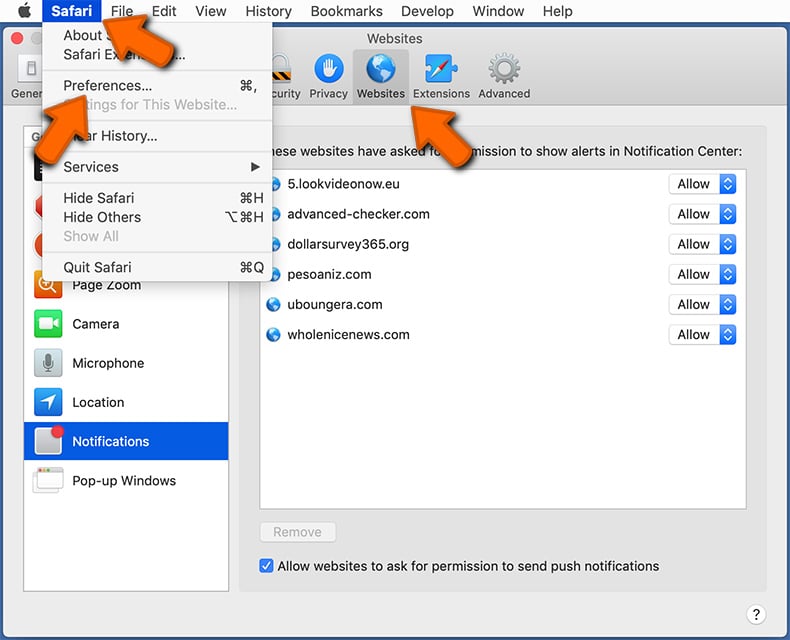
Check for suspicious URLs and apply the "Deny" option using the drop-down menu or either remove them by clicking "Remove" at the bottom of the window (if you click "Remove" and visit the malicious site once more, it will ask to enable notifications again)
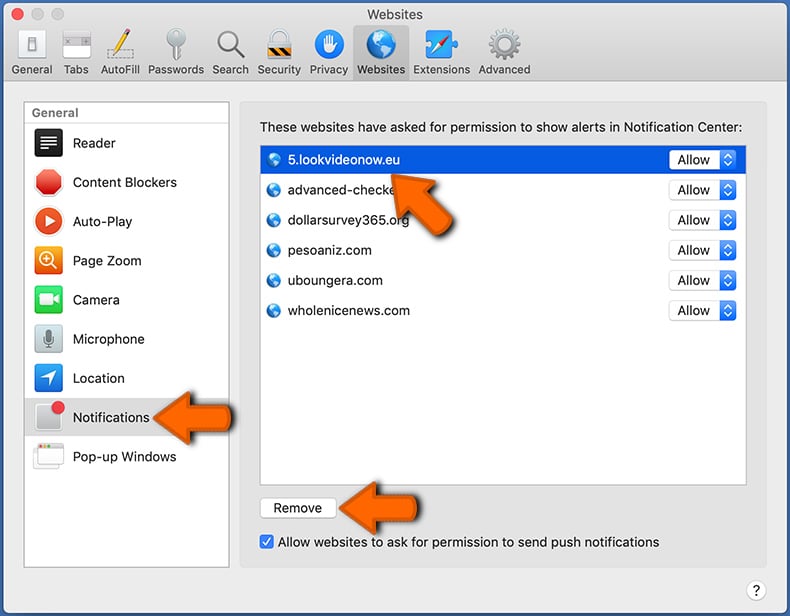
How to avoid browser notification spam?
Internet users should be very skeptical when being asked to allow notifications. While this is a useful feature that allows you to receive timely news from websites you like, deceptive marketers frequently abuse it.
Only allow notifications from websites that you fully trust. For added security - use an anti-malware application with a real-time web browsing monitor to block shady websites that tries to trick you into allowing spam notifications. We recommend using Combo Cleaner Antivirus for Windows.
Frequently Asked Questions (FAQ)
Why am I seeing ads (browser notifications) delivered by pushnote[.]top in the right lower corner of my desktop?
Sites require user permission to display browser notifications. Therefore, if you seeing these advertisements from pushnote[.]top - means you've likely visited this site and permitted it to deliver them. In other words, pressed "Allow", "Allow Notifications", or a similar option presented on pushnote[.]top.
I have clicked on notification ads, is my computer infected?
No, clicking on a browser notification is harmless in itself. However, the sites and applications promoted via these ads can be dangerous and cause serious issues (including system infections).
Is pushnote[.]top a virus?
No, pushnote[.]top is not considered to be a virus, but it can push virulent content. Websites of this type frequently endorse scams, fake/harmful software, and malware.
Will Combo Cleaner remove pushnote[.]top ads automatically or manual steps are still required?
Yes, Combo Cleaner will scan your device and undo pushnote[.]top permissions. Additionally, Combo Cleaner can restrict all further access to this and other rogue, deceptive, and malicious webpages. Hence, extra steps will be unnecessary.
Share:

Tomas Meskauskas
Expert security researcher, professional malware analyst
I am passionate about computer security and technology. I have an experience of over 10 years working in various companies related to computer technical issue solving and Internet security. I have been working as an author and editor for pcrisk.com since 2010. Follow me on Twitter and LinkedIn to stay informed about the latest online security threats.
PCrisk security portal is brought by a company RCS LT.
Joined forces of security researchers help educate computer users about the latest online security threats. More information about the company RCS LT.
Our malware removal guides are free. However, if you want to support us you can send us a donation.
DonatePCrisk security portal is brought by a company RCS LT.
Joined forces of security researchers help educate computer users about the latest online security threats. More information about the company RCS LT.
Our malware removal guides are free. However, if you want to support us you can send us a donation.
Donate
▼ Show Discussion